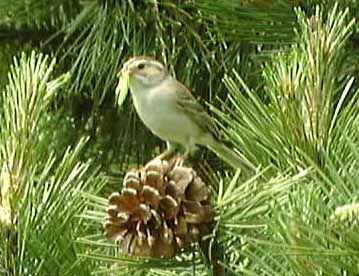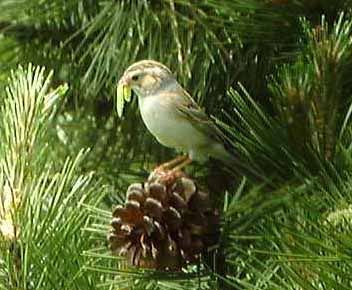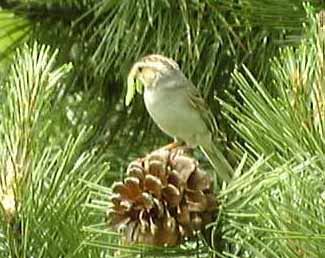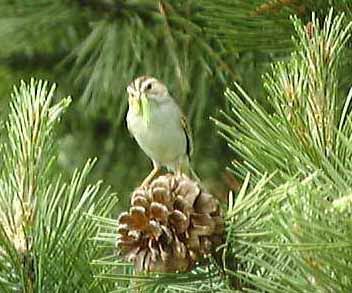
Three Clay-colored Sparrows were observed at Piney Tract in Clarion County on 5 June 1999. One of these still displayed first winter/immature plumage and may have been born at Piney Tract in 1998. John Fedak believed Clay-colored Sparrows nested at Piney Tract in 1998, and this individual may have been one of the chicks from that year. The young bird probably returned to the area it imprinted on as a chick. This bird had a buffy central head stripe and flaking brown outilined in black head stripes. The eyebrow stripe was basically white, but there was a yellowish spot above the eye. The breast was a buffy tan-color while the belly was a lighter off-white color.
The other two were an adult pair that was nesting at Piney Tract in 1999. We did hear the buzz-buzz-buzz call of these Clay-colored sparrows on several occasions. The individual believed to be the male had stronger or more intense markings than the one believed to be the female. The male had a more noticeable cheek patch, darker lines outlining the check patch and the head stripes were bolder. It had a white central head stripe and white eyebrow. The breast and belly of the male was an off-white color and the nape of the neck was noticeably gray. The female is described below with its photographs.
Both male and female adults were observed carrying green worms or caterpillers to a pine tree (Margaret Buckwalter indicates it is a red pine), and this was interpreted as feeding behavior for their chicks. The female appeared to stay closer to the nest site and returned more often than the presumed male. The female also seemed to have a favored perch (a pine cone) that she would stop on and check the surrounding area for potential threats before diving into the tree to feed the chicks. The female was also observed carrying a fecal sac away from the nest site. The pair dove down into a dense lower section of the pine, about one foot off the ground as best we could estimate. That is the probable location of the nest. We made no attempt to directly observe the nest for fear it would be marked with human scent for predators. We set up near another pine (to keep the birds from seeing our sillouhettes against the sky) located approximately 30 feet north of the pine where the birds were observed bringing in food.
They were observed for about 45 minutes. All of the accompanying photographs of the presumed female were taken by Mark McConaughy with a digital camera held up to the objective of his spotting scope. The scope was set to view the favored perch of the female so pictures could be snapped when she arrived. The male did not seem to have a set pattern of entry to the nesting area and we were not able to get a good photograph of that bird.

This picture shows the female in profile. The white eyebrow stripe and light brown check patch outlined with darker stripes is noticeable. There also is a submoustachial stripe characteristic of the species. The gray nape of the neck can also be seen in this picture. The breast is a light gray to off white and it is not streaked or spotted. She has a green caterpillar or some type of worm in her mouth.

This photograph provides an even better view of the white eyebrow strip, outlined light brown check patch, gray nape of the neck and the lighter unstreaked breast of the bird. It also shows one of the crown stripes which is brown bordered with darker lines. She is carrying the same caterpiller/worm as in the preceding picture. This shot was taken only seconds after the first. one.

This view shows the back of her head and the white central strip that runs over it. The white central stripe is bordered on either side with brown stripes that are themselves bordered by darker black lines. The gray nape of the neck and unstreaked breast is also noticeable in this shot. This picture was taken earlier than the preceding two shots and she is carrying a different green caterpiller/worm than the one in those shots.

This is a good head-on shot of the female Clay-colored Sparrow. It shows the white crown stripe flaking brown outlined in black side head stripes and white eyebrow stripes of the bird. The check patch and lighter, unstreaked breast are also viewable. The males markings were bolder than these. The worm she is carrying is a different one from those in the other three pictures. This was actually one of the first shots that was taken of the bird.
Return to McConaughy's Birding Page
Return to McConaughy's Home Page